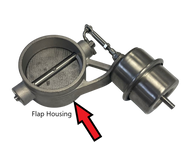Diagnosing Actuator Failure in Exhaust Valve Kits Why Your Valve Flap May Be Fine — But Your Actuator Isn't Working
Posted by Top Speed Pro1 on 8th Jul 2025
Having trouble with your valved exhaust system? Sometimes the problem isn’t the valve flap at all — it’s the actuator. If your valve doesn’t open or close properly, this quick guide will help you understand and test the actuator before replacing parts or sending anything back.
Signs Your Actuator May Be Failing
- The valve stays stuck open or closed, even with vacuum applied
- No movement from the actuator rod
- No sound or clicking when the system activates
- The system seems unresponsive even though the flap moves freely
Why the Actuator Fails First
While valve flaps are usually made from stainless steel and just need occasional cleaning, the actuator is more delicate. It uses a rubber diaphragm inside to create vacuum pressure — and that rubber can wear out over time, especially if your car runs hotter or is tuned for performance.
- High engine bay temps can damage the diaphragm
- Excessive pressure from tuning wears it out faster
- Once the rubber weakens or leaks, the actuator stops working
How to Test the Actuator at Home
You can check the actuator with a simple handheld vacuum pump (like a Mityvac). Here's how:
- Connect the pump to the actuator’s vacuum port
- Pump to –10 inHg vacuum
- The rod should move in or out smoothly
- The vacuum should hold for 30+ seconds
- When you release the vacuum, the rod should return freely
❌ If the rod doesn't move or vacuum leaks out — it's time for a new actuator.
Simple Tips to Keep It Working
- Keep valve flaps clean to avoid carbon buildup
- Let your car warm up before hard revving
- Check vacuum lines for cracks or leaks
- Never spray oil or lube inside the actuator
Final Thoughts
If your valved exhaust system isn’t working, don’t panic — and don’t replace the entire system right away. The actuator is often the problem, and it’s usually an easy fix. A quick test can save you time, money, and frustration.
Still not sure? Contact our support team — we're here to help.



